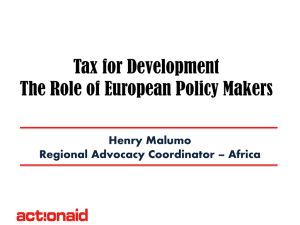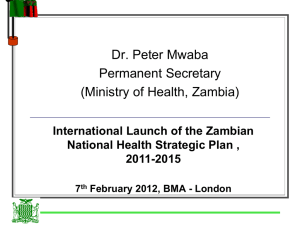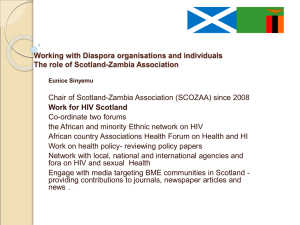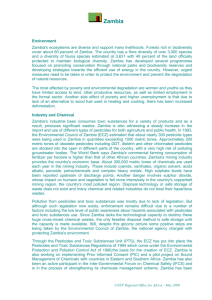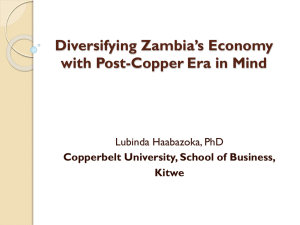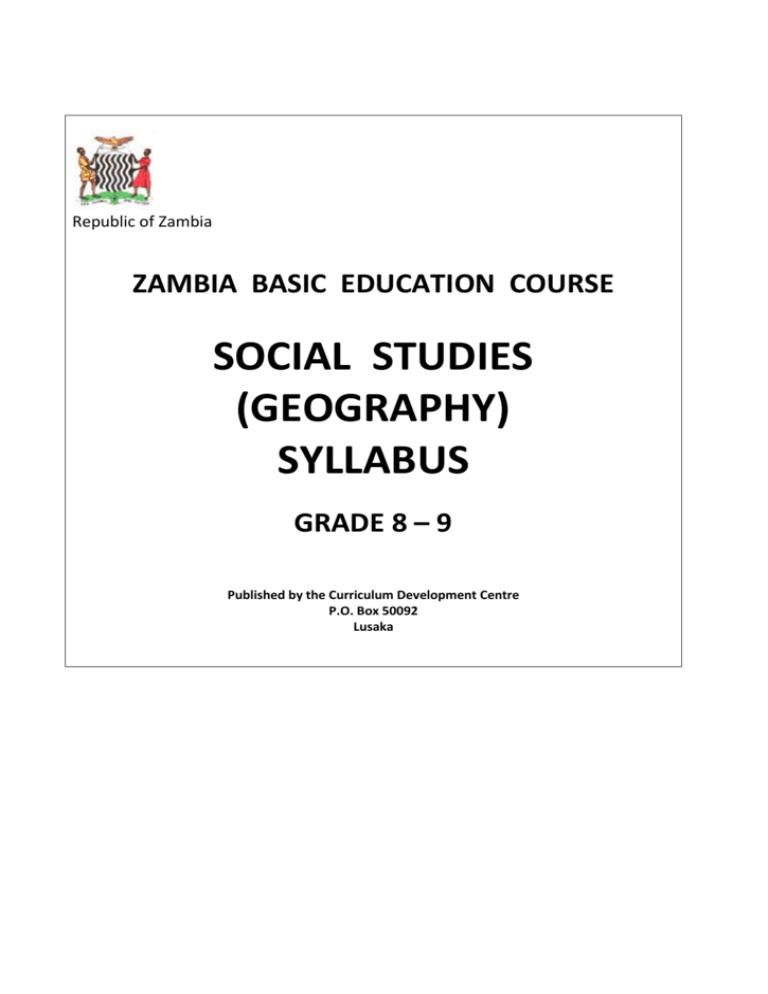
Republic of Zambia
ZAMBIA BASIC EDUCATION COURSE
SOCIAL STUDIES
(GEOGRAPHY)
SYLLABUS
GRADE 8 – 9
Published by the Curriculum Development Centre
P.O. Box 50092
Lusaka
ZAMBIA BASIC EDUCATION COURSE
SOCIAL STUDIES
(GEOGRAPHY)
SYLLABUS
GRADE 8 – 9
Published by the Curriculum Development Centre
P.O. Box 50092
Lusaka
(c) All rights Reserved. No parts of this syllabus may be produced, stored in a retrieval
manner, transmitted in any means without the prior consent of the copyright owner.
Phototypeset and printed by Printpak (Z) Ltd.
TABLE OF CONTENTS
Pages
Acknowledgements
...............................................................................................I
Preface.......................................................................................................................II
Introduction...............................................................................................................III – IV
General Goals............................................................................................................IV – V
Social Studies (Primary)..........................................................................................1- 33
Social Studies (Junior Secondary)..........................................................................33-47
PREFACE
THIS Social Studies Syllabus has been prepared against the back ground of Educational
Reform. It takes into account the new structure of the School Curriculum. Its composite
features of Basic Education is evident of the new structure. It is an aspect of both the
Educational Reform and Curriculum implementation. It attempts to meet the requirements of
the Reform.
One other thing which is significant in the syllabus is the provision of carefully planned and
sequenced subject and content (UNIT) objectives. The subject-matter covering knowledge,
skills and attitudes is blended in an integrated approach. Field activities and projects do not
only reinforce this integrated concept but also broaden the experiences and opportunities.
The strongest point about this syllabus is that learning experiences start from KNOWN to
UNKNOWN. The learner, therefore, is first well introduced to THINGS around him/her. In
this way the learner interacts with, and experiences both the immediate and distant
communities and environments, all of which centre around local, regional, Africa and global
context. These specific objectives provide the bases for achieving the aims of basic
knowledge, skills methods and strategies such as collecting data, organisation of materials
and interpretation. Above all, it aims at inculcating values such as social interaction, decision
extrapolation.
To achieve all these, teaching/learning processes will require practicals, dramatisations,
projects and field visits. The syllabus focuses on the ability to acquire knowledge and skills,
the need to develop positive and desirable attitudes; the potential to tackle challenges posed
by political, cultural, social and economic needs and factors. In this way, the syllabus
contributes to the TOTAL DEVELOPMENT OF THE INDIVIDUAL, THE COMMUNITY
AND SOCIETY BOTH IMMDIATE AND DISTANT.
Chairman
EXAMINATIONS COUNCIL OF ZAMBIA
DIRECTOR
CURRICULUM DEVELOPMENT CENTRE
LUSAKA
ACKNOWLEDGEMENTS
THE members of staff of the Social Studies Department and members of the Social Studies
Curriculum Committee of the Curriculum Development centre are indebted to the Primary
and Secondary School teachers, College lecturers and the Inspectorate of both the Ministry of
Higher Education and the Ministry of General Education and Culture for their professional
contributions to the production of this syllabus.
The members also register their sincere thanks to UNICEF for its generosity in funding the
workshops at which the materials for the syllabus were produced. Thanks are also extended
to the Typing Staff at the Curriculum Development Centre for working tirelessly and
patiently in order to produce this document.
INTRODUCTION
THIS new syllabus for Basic Education was formulated as one of the initial steps towards the
implementations of the Educational Reforms in the Zambian Educational system. Basic Education is
understood to be the kind of education which the pupils will receive from Grade 1 through Grade 9. It
aims at providing the pupils with the basic knowledge which any pupil who passes through the system
will need whether he or she joins the world of work, proceeds to Grade 10 or joins a vocational
training institution after Grade 9. In the syllabus, each Unit represents the main Topic. Each main
Topic is divided into sub-topics to which the objectives are written in behavioural terms, thus, the
abbreviations PSBAT: stands for PUPILS SHOULD BE ABLE TO: These specific objectives
provide the bases for achieving the aims of basic knowledge, skills methods and strategies such as
collecting data organisation of materials and interpretation. Above all, it aims at inculcating values
such as social interaction, decision extrapolation.
It should be noted that the philosophical essence of teaching this syllabus shall be reflected by the
teachers in providing answers to the following questions related to the appropriate Units of instruction
at various Grade levels:(i)
Why should we teach the selected “Social Studies” Units to a specific Grade?
If we should teach it at all, should we emphasise factual knowledge, basic concepts,
critical thinking, values, or some other objectives?
(ii)
What methods are available to us? How do we select which ones to use?
(iii)
What subject or content areas are most important to teach? How should such
content emphasis be selected?
The syllabus further take into account our National educational Goals and the structure of the
various disciplines that contribute to the subject called “Social Studies”. For instance, one of
the main National Goals in the “achievement of an all-round development of the pupil
through self-reliance of an individual.” It is for this reason that the specific objectives of
the syllabus aim mostly at equipping the pupils with productive skills. The syllabus
emphasises the various approaches adopted in learning such disciplines in an integrated
manner. The subject matter arranged n a spiral fashion, that is, dealing with the same Topic,
moving from simple to complex, while at the higher grades the study extends in breath and
depth. The syllabus takes into account factors of space, time perspective, political, and social
economic changes.
In keeping with the Philosophy of Humanism, all the teaching and learning centres around
Man. Thus, the syllabus emphasises the ways and means through which man produces food,
how he organises himself, and the interdependence of the human race. It also takes into
account the fact that Man should be aware of his physical and non-physical environments.
At Grades 3 – 7 levels the syllabus is arranged in a much more general manner but at the
same time knitting together the topics in a much more integrated fashion. This provides a
broad but a unified whole of knowledge as is essential for the learner on the early stages of
intellectual development.
At Grade 8 and 9 level the syllabus again focuses on Man’s Past, Present and Future
Environment at a much more advanced level than at Primary level.
Here, skills, concepts and methodologies such as the acquisition of research techniques, the
locality space, time, conflict and change are all brought into a much sharper onus. This
provides a take-off stage to Grade 10 to 12 where more specialisation will be necessary. The
syllabus, therefore, pays particular attention to the teaching and learning of fundamental
concepts, skills, specialisation and methodologies. It is, therefore the ultimate goal of this
syllabus to develop in the learners knowledge and intellectual skills that will help them
understand their social, political and economic world so that they can think and act most
effectively.
Time allocation is as follows:(i)
Grade 3-4, 2 periods per week of 30 minutes duration each
(ii)
Grade 5-7, 3 periods per week of 40 minutes duration each
(iii)
Grades 8 and 9, 4 periods per week of 40 minutes duration each.
GENERAL GOALS FOR SOCIAL STUDIES FOR BASIC EDUCATION AT THE END OF
GRADE 9
1.
Develop an understanding of the functions of Social Institutions and roles of
individuals and groups in different cultural settings in both the past and present.
2.
Understanding of the influence of values, traditions, technological, educational and
cultural developments on individual and group behaviour.
3.
Development of an understanding of the social, political, economic, geographical and
historical factors which determine man’s progress and welfare.
4.
Creation of an awareness of man’s interaction with his environment.
5.
Acquisition and application of basic Social Studies skills, methods and techniques.
6.
Creation of an awareness of political, economic and social developments which have
taken place in Zambia before and after independence.
7.
Creation of an understanding of democratic beliefs such as civil and human rights.
8.
Development of positive attitudes to the motto to ONE ZAMBIA ONE NATION.
9.
Development of an understanding and appreciation of man’s development and
growth.
10.
Development of an understanding of the influence of the past on the resent and
appreciation for a need to change..
11.
Development of a sense of National Unit and appreciation of the relationships
between events within the context of historical experiences shared with other
communities.
12.
Development of a moral responsibility for the preservation and improvement of the
natural and cultural heritage.
13.
Creation of an awareness of the consequences of Western European expansion.
14.
Assessment of the norms, values, attitudes, and systems of beliefs which influence
people’s attitudes towards population issues.
15.
Understanding the relationship between the population trends in Zambia and socioeconomic development at micro and macro levels.
16.
Assessment of the impact of legal mechanism and rational change of population
awareness on cultural factors of high fertility behaviour.
17.
Development of an understanding of the determinants of populations growth in our
country.
18.
Development of an assessment of the effect of our population on maternal and child
health as well as adult health
19.
Development of an understanding that human society is formed in accordance with
condition of geographical locations and that its growth is maintained through the
process of replacement.
20.
Develop the knowledge base that man is a geological being and is part of the ecosystem
on the earth.
21.
Development of a positive attitude towards the plan for child rearing by learning the
fact that optimum population size of a nation is reached through optimum family size.
22.
Development of a rational argument for and against methods of family planning or
child spacing and suggest morally acceptable methods.
UNIT 2
GRADE 8 GEOGRAPHY
MAN AND HIS ENVIRONMENT
TOPIC 2.1
Physical and cultural features of Zambia
Objectives:
2.1.1
At the end of the learning experience, PSBAT:name the physical and cultural features found in their locality and in Zambia
as a whole.
explain the differences in these features,
explain the meaning of the terms used when describing physical and cultural
features, for example, valley, hill, river, forest, hot desert, cold desert etc.,
describe how some of the above features are formed,
analyse how these features influence the lives of people in terms of
settlements, economics activities, transportation systems etc.,
discuss how people’s cultures influence the use of the physical and cultural
features,
given a map of Zambia, recognise and read accurately the many symbols,
using the map symbols, locate and name the physical and cultural features on
the map.
2.1.2
2.1.3
2.1.4
2.1.5
2.1.6
2.1.7
2.1.8
TOPIC 2.2
Relief and drainage systems of Zambia
Objectives:
2.2.1
At the end of the learning experience, PSBAT:explain the meaning of the following terms; delta, confluence, tributary, basin,
estuary, watershed and mouth.
list down the relief features which are used as a resource e.g. tourist attraction,
mining, farming lands, rivers for fishing and for generating hydro-electric
power, etc.,
discuss why certain features change, for example, due to either natural causes
such as floods or the rapture of active volcano mountain or man’s activities on
the environment such as farming, building, mining, deforestation,
afforestation, etc.,
write symbols for these features,
given ordinance topographic maps, interpret the drainage patterns, rainfalldistribution, vegetation system and settlement patterns,
draw maps to show land-forms or relieve-patterns such as drainage, settlement
patterns, land use and communication patterns
list down some examples of individuals or groups of people who would be
eligible to be helped by others.
2.2.2
2.2.3
2.2.4
2.2.5
2.2.6
2.2.7
TOPIC 2.3
Weather and climate of Zambia
Objectives:
2.3.1
2.3.2
2.3.3
At the end of the learning experience, PSBAT:explain the meaning of climate and weather,
Describe the different between the two,
correctly use weather instruments in recording daily, weekly, monthly and
yearly weather,
explain the contributing factors to the variations of weather in Zambia,
interpret different weather symbols,
explain the influence of weather and climate on the life of living things,
describe how weather and climate influence human activities and how human
activities influence weather and climate,
draw weather charts and climatic maps and graphs and write in symbols to
interpret them.
2.3.4
2.3.5
2.3.6
2.3.7
2.3.8
TOPIC 2.4
Objectives:
2.4.1
2.4.2
2.4.3
2.2.4
2.4.5
2.4.6
2.4.7
Rainfall in Zambia
At the end of the learning experience, PSBAT:explain the meaning of temperature and rainfall,
list down the different types of rainfall in Zambia and explain how they are
formed,
explain the factors which influence the variations in temperature and rainfall
in Zambia.
describe the difference between maximum and minimum temperatures,
given the correct measuring instruments, measure and record the following:- temperature, rainfall, wind direction and speed, and the state of the sky
(atmosphere) in any one given day, week, moth or year,
analyse the relationships between the temperature, rainfall, vegetation, soil and
food crops in Zambia,
draw diagrams of land and sea breezes and write an account of how they are
caused.
TOPIC 5.3
Population of Zambia
Objectives:
5.3.1
At the end of the learning experience, PSBAT:Define the following terms:- family, community, nation, population,
urbanisation, migration, population density, census,
5.3.2 discuss the types of rural and urban settlements in Zambia
5.3.3 describe the factors which affect and influence the location and pattern of
human settlement.
5.3.4 give reasons for the difference in the density of population between rural and
urban areas,
5.3.5 identify and list down the types of social services provided by the Zambian
Government in both urban and rural areas,
5.3.6 compare and contrast rural and urban communities in relation to their living
pattern (standards),
5.3.7 analyse the causes and consequences of rural-urban drifts and suggest ways by
which the government would effectively discourage this trend,
5.3.8 name the factors f population distribution in Zambia (physical and social
factors).
5.3.9 give reasons why some urban centres have gained in population and others
have lost,
5.3.10 locate on the map of Zambia, areas of sparse and dense population and give
reasons for the differences in the densities.
UNIT 6
RESOURCES AND ECONOMY OF ZAMBIA
TOPIC 6.1. Subsistence farming.
Objectives:
6.1.1
6.1.2
6.1.3
6.1.4
6.1.5
6.1.6
6.1.7
6.1.8
6.1.9
At the end of the learning experience, PSBAT:identify and name the various traditional farming methods used in Zambia,
name the chief subsistence crops that are grown in different parts of Zambia,
explain how the livelihood of man is controlled by the resources,
analyse the impact and effect or rainfall distribution, soils and landscapes on
the different systems of farming and the different types of crops,
list down ways of improving crop-production in any given area (this will
include manuring, fertilising and the use of pesticides to control disease),
discuss the importance of crop rotation,
gather data on traditional farming from resource persons printed materials,
radio or television,
analyse and explain the influence and impact of certain traditions of farming,
explain the role of technology in the farming systems today in Zambia
TOPIC 6.2
The Agrarian Revolution in Zambia
Objectives:
6.2.1
6.2.2
6.2.3
At the end of the learning experience, PSBAT:explain the meaning of the term ‘Agrarian Revolution’.
discuss the areas of change in the Agrarian Revolution in Zambia
state the reasons for the Government-shift of emphasis from copper-mining to
the Agrarian Revolution,
analyse and assess the successes and failures of the project being carried out
by the Zambian government in the Agrarian Revolution.
evaluate the success of the Agrarian Revolution in Zambia.
6.2.4
6.2.5
TOPIC 6.3
Commercial farming
Objectives:
6.3.1
6.3.2
6.3.3
At the end of the learning experience, PSBAT:define the term ‘Commercial Farming’.
locate and name on the map of Zambia, the commercial farming areas,
discuss the factors that have affected the distribution of commercial farming
areas in Zambia.
describe the role of commercial farming to the Gross National Product
(G.N.P.).
discuss the advantages and disadvantages of both traditional and commercial
farming.
explain the role of the Zambian Government in encouraging farming
discuss problems encountered in farming systems in relation to land, rainfall.
Chemical, tools, demands, transportation and storage,
analyse and compare the basic requirements for growing different types of
crops.
6.3.4
6.3.5
6.3.6
6.3.7
6.3.8
TOPIC 6.4.
Zambia’s natural resources.
Objectives:
6.4.1
6.4.2
6.4.3
At the end of the learning experience, PSBAT:explain the meaning of the term ‘resources’.
give an account of the nature of resources 9renewable and non-renewable),
discuss the promotion and the use of resources in the country and suggest
ways of conserving them,
analyse the impact of population growth on limited resources in Zambia.
6.4.4
UNIT 7
RESOURCES AND ECONOMY OF AFRICA
TOPIC 7.1. Coffee, cotton and cocoa cultivation.
Objectives:
7.1.1
7.1.2
7.1.3
7.1.4
7.1.5
7.1.6
7.1.7
7.1.8
7.1.9
At the end of the learning experience, PSBAT:define the terms ‘plantation crops’ and ‘beverages’.
discuss how coffee, cotton and cocoa are processed,
describe the geographical conditions necessary for the cultivation of coffee,
cotton and cocoa and explain briefly how each crops is cultivated,
list down the different varieties of coffee, and match each with the area of its
origin,
collect and record statistics of coffee, cotton and cocoa production in the area
under study and compare the graphs with other produce,
interpret graphs to illustrate the trends and pattern of coffee, cotton and cocoa
production and distribution in Africa
analyse the relationships of E.E.C. and A.C.P. countries in the development of
trade in coffee and cocoa,
draw a map of Africa and locate the areas where coffee, cotton and cocoa are
cultivated,
assess the advantages and disadvantages of mono-culture (growing one crop
on a farm or garden).
TOPIC 7.2. Commercial livestock production in Africa
Objectives:
7.2.1
7.2.2
7.2.3
7.2.4
7.2.5
7.2.6
At the end of the learning experience, PSBAT:identify and describe the conditions which favour or induce commercial
livestock production in Botswana and other parts of Africa,
name and list the animals to which commercial farming is devoted in
Botswana
name the most important products of commercial livestock production in
Botswana and list the most important markets for her products,
discuss the important of the carrying capacity or grazing lands,
explain the role of African governments in promoting livestock production,
explain the effect of tsetse fly infestation in rearing livestock.
TOPIC 7.4.
Objectives:
7.4.1
7.4.2
7.4.3
7.4.4
7.4.5
7.4.6
7.4.7
At the end of the learning experience, PSBAT:identify the oil fields and refineries and name most important oil producing
countries in Africa and the Middle East,
construct and interpret graphs and crude oil production and economic
development of the countries in Africa.
list down oil importers from Africa
compare and contrast the relative importance of petroleum with other sources
of energy.
investigate the relationship between petroleum production supply, distribution
and utilisation of various industries,
name the member countries of OPEC and assess its role in petroleum
production and export, in Africa,
in view of the scarcity and ever-rising price of petroleum, discuss various
alternatives to petroleum production e.g. the use of local and sugar-molasses
to produce fuel.
UNIT 8
INDUSTRIAL DEVELOPMENT IN ZAMBIA
TOPIC 8.1. Industry and types
Objectives:
8.1.1
8.1.2
8.1.3
8.1.4
At the end of the learning experience, PSBAT:explain the meaning of industry and factory,
classify and give examples of the different types of industry under the
following headings: Primary, Secondary and Tertiary,
locate on the map of Zambia, the main industrial areas,
Identify and discuss the natural and acquired factors which influence the
location of an industry,
TOPIC 8.2. Forestry [ a resource based industry].
Objectives:
8.2.1
8.2.2
8.2.3
8.2.4
8.2.5
8.2.6
8.2.7
At the end of the learning experience, PSBAT:identify and name the important timber trees in Zambia,
define the following terms: ‘plantation’, ‘deforestation’,
name and locate the distribution of forests in Zambia,
classify timber and wood products according to their uses in Zambia,
discuss the limitations in the development of plantations, due to physical and
climatic conditions of Zambia.
explain the significance of markets for timber industry in Zambia,
discuss the role played by the Zambian Government in developing industrial
plantations,
8.2.8
8.2.9
suggest ways of making Zambia self-sufficient in timber products and explain
how rural industries based on forest resources could be developed,
explain the impact of population growth on forests as a national resource.
TOPIC 8.3. Fishing [a resource based Industry].
Objectives:
8.3.1
8.3.2
8.3.3
8.3.4
8.3.5
8.3.6
8.3.7
8.3.8
8.3.9
8.3.10
8.3.11
8.3.12
8.3.13
8.3.14
At the end of the learning experience, PSBAT:name the important fisheries in Zambia
list down the most common types of fish caught in Zambia,
explain why different fish species are found in different lakes and rivers i
Zambia
describe the different methods of fishing that are used in Zambia,
discuss the problems of fishing faced by the fishing industry in Zambia
suggest ways and means of improving the fishing industry,
explain how fish is processed for marketing,
explain how fish is processed for marketing,
explain the role of the Department of Game and Fisheries,
discuss and give examples of the main use of fish
collect yearly data on each of the main fisheries to construct graphs on the
fish production to show trends and patterns,
identify and name the endangered fish species to Zambia fisheries,
identify and name government fishing regulations and give reasons for such
kind of controls,
identify and name some important fish-based industries.
TOPIC 8.4. Tourist industry in Zambia and Kenya [another resources based i
industry].
Objectives:
8.4.1
8.4.2
8.4.3
8.4.4
At the end of the learning experience, PSBAT:explain the meaning of ‘tourism’ and ‘tourists’
list the different tourists attractions in Zambia and local these on the map,
discuss the importance of wild life as a tourist attraction in Zambia
collect statistics on the flow of tourist per year and estimate the value of
earnings from the trade,
8.4.5 discuss the government policy regarding the promotion of the tourist industry
in Zambia
8.4.6 compare and contrast tourism in Zambia and Kenya,
8.4.7 explain the ways in which the tourist industry assists rural residents in
countries where the industry exists,
8.4.8 discuss why tourism has become an important foreign exchange earner in
Zambia and Kenya.
8.4.9 discuss the advantages and disadvantages of the tourist industry,
8.4.10 locate and name the Game Reserves and National Parks on the map of
Zambia,
8.4.11 list some of the types of animals founds in the Game Reserves and National
Parks,
8.4.12 explain the following terms: Game Cropping (including lawful or licensed
hunting), Game Guard, Game Scout Ranger, poaching, over stocking, overcropping and carrying capacity,
8.4.13 discuss the role of the Wildlife Conservation Society of Zambia and The Save
Rhino campaign,
8.4.14 give reasons why it is important to conserve wild life,
8.4.15 classify animals found in Zambia under herbivores and carnivores,
8.4.16 critically assess the impact of smuggling ivory, rhino horns and skins of wildlife,
8.4.17 identity and name some of the wild animals which might become extinct e.g.
rhino, elephants, etc..
8.4.18 assess the impact of population trends on wild life in Zambia.
UNIT 1
GRADE 9
MAN THE MAP-MAKER
TOPIC 1.1. The tools of a geographer
Objectives:
1.1.1
1.1.2
1.1.3
1.1.4
1.1.5
1.1.6
1.1.7
1.1.8
At the end of the learning experience, PSBAT:explain the meaning of contour lines, spot height, conical hill, plateau, ridge,
cliff and other related features.
given a map of Africa, recognise and read accurately the map symbols,
accurately read four and six figure grid references,
measure distances on maps using the various types of scales,
accurately work out a gradient between two given points on a map,
calculate grid bearing from grid north,
describe and use the methods of representing relief on map
interpret the following from a given map: relieve, drainage, settlement,
communication, land use and vegetation.
UNIT 2
POWER AND ENERGY IN ZAMBIA
TOPIC 2.1. Sources of power and energy.
Objectives:
2.1.1
2.2.2
2.1.3
2.1.4
2.1.5
2.1.6
At the end of the learning experience, PSBAT:explain the meaning of power and energy,
identify and name the different types of sources of energy,
identify the different types of energy (renewable and non-renewable),
explain the meaning of the following terms: renewable and non-renewable
sources of energy,
collect data and draw graphs on the use of wood fuel, coal, liquid, fuel and
electricity,
explain the cause for international interest in the development of new and
alternative sources of power or energy,
TOPIC 2.2. Institutions supplying energy
Objectives:
2.2.1
2.2.2
2.2.3
2.2.4
2.2.5
2.2.6
At the end of the learning experience, PSBAT:identify and name the energy generating and supplying institutions, e.g.
Zambia Electricity Supply Corporation (ZESCO), Copperbelt Power Company
Limited (C.P.C.), Central African Power Corporation Limited (C.A.P.C.),
Kariba North Bank Hydro-Power Plant, Kafue Gorge Hydro-Power Plant,
Victoria Falls Hydro-Power and Musonda and Chishimba Falls Hydro Power
Plants,
Explain the economic importance of energy generating and supply with regard
to Maamba Colliery, Tazara Pipeline and Indeni Oil Refinery,
identify and name the physical requirements that favour the construction of the
H.E.P. Station,
undertake local sample study of either thermal or hydro-electrical power
station,
discuss various ways by which the Zambian Government is developing and
supplying energy in Zambia,
explain the role played by ZESCO and Zambia Energy Goard.
UNIT 3
ENERGY CONSUPTION IN ZAMBIA
TOPIC 3.1. Energy consumption in Zambia
Objectives:
3.1.1
3.1.2
3.1.3
3.1.4
3.1.5
3.1.6
3.1.7
At the end of the learning experience, PSBAT:analyse the relationships of energy consumption between industries and homes
and give reasons for the difference,
give reasons why power and energy are necessary in both homes and
industries,
assess the impact of population growth on both the demand and supply of
energy resources.
explain why in some areas of Zambia thermal or H.E.P. stations are used,
draw bar-graphs of energy consumption in homes and industries and interpret
the differences,
discuss various methods or ways of conserving energy in homes and
industries,
assess the socio-economic implication of rural electrification.
TOPIC 3.2. The physical features of Africa
Objectives:
3.2.1
3.2.2
3.2.3
3.2.4
3.2.5
3.2.6
3.2.7
3.2.8
3.2.9
At the end of the learning experience, PSBAT:identify, locate and classify the physical features of Africa e.g. mountains,
rivers, lakes, etc.
locate and describe the position of the Rift Valley and other important features
associated with it,
explain the effect of relief on economic development in terms of:
transportation and communication, settlements, agriculture, and population
distribution,
compare and contrast human life in the different regions,
state clearly the agents of erosion and deposition and their effects on Africa’s
landscape,
explain the following terms with examples: erosion, river capture, meandering,
lagoon, ox-bow lake and other related features,
state clearly the agents of erosion and their effects,
identify and discuss the advantages and disadvantages of rivers and lakes, e.g.
flooding, silting and transportation,
draw a map of Africa an label the different types of land forms associated with
denudation (erosion) and deposition.
TOPIC 3.3. The climatic and natural regions of Africa.
Objectives:
3.3.1
At the end of the learning experience, PSBAT:explain the following terms: air pressure, air humidity, temperature, weather,
climate, natural region (in terms of its characteristics) evaporation,
condensation,
3.3.2 name the different weather instruments and explain how they are used,
3.3.3 discuss the factors which influence climate and temperature,
3.3.4 name the three basic types of cloud and describe the process of their
formation,
3.3.5 discuss the different types of rainfall and explain how each is formed.
3.3.6 explain the causes of land and sea breezes,
3.3.7 Describe the different types of climate of Africa,
3.3.8 collect data on mean monthly temperature and rainfall, and use this
information in drawing bar and line graphs,
3.3.9 describe the relationships among climate and vegetation, agriculture,
recreational activities and tourism,
3.3.10 discuss the influence of Africa’s relief on climate,
3.3.11 calculate the mean monthly temperature, rainfall and annual range of
temperature,
3.3.12 describe the pattern of pressure and winds in Africa,
3.3.13 explain how man influences different types of vegetation e.g. by planting,
cutting, burning, etc.,
3.3.14 draw a map of Africa an insert in the most important physical features,
climatic and natural regions and wind systems,
3.3.15 calculate the daily mean 9average) temperature, mean monthly temperature
and mean annual temperature and rainfall based on the data from selected
regions.
3.3.16 locate and name all the natural-regions of Africa,
3.3.17 identify and describe the tropical temperature and frigid zones,
3.3.18 discuss the most important economic commodities produced, in each of the
natural regions of Africa,
3.3.19 compare and contrast the ways of life of the people in each of the natural
regions of Africa.
3.3.20 explain the relationship among climate, vegetation and economic activities in
the natural regions of Africa and give reasons for their differences in the
economic development,
3.3.21 interpret rainfall and temperature graphs of the natural regions of Africa,
3.3.22 draw temperature, rainfall and agricultural graphs of the natural regions of
Africa.
3.3.23 explain the causes of deserts and locate and discuss their distribution in Africa,
3.3.24 make a list of suggesting on how to stop the deserts from spreading,
3.3.25 assess the impact of human activities on natural regions.
UNIT 7
POPULATION OF AFRICA
TOPIC 7.1.
Objectives:
7.1.1
7.1.2
7.1.3
7.1.4
7.1.5
7.1.6
7.1.7
7.1.8
7.1.9
At the end of the learning experience, PSBAT:explain the following concepts: population, census, birth rate, death rate,
natural increase and migration,
identify and explain factors which have influenced Africa’s population growth
rate (i.e. determinants of population growth),
Identify and explain the socio-economic problems of rapid population growth
to African nations,
calculate birth rate and death rate on the basis of collected data,
draw population age-sex pyramids of some African countries and determine
whether or not their populations are young,
estimate the total population of Africa by the year 2000 on the basis of present
day population growth rate,
assess the impact of population growth on the provisions of social and
economic services (health, housing, education, food and employment).
explain the importance of census and evaluate national population as an
economic resource in national development,
explain the problems of census in African countries and suggest easy of
solving them.
TOPIC 7.2. Population distribution and densities
Objectives:
7.2.1
7.2.2
7.2.3
7.2.4
7.2.5
7.2.6
7.2.7
At the end of the learning experience, PSBAT:identify and name the most important races
define the term ‘population density’,
locate on the map of Africa areas of very dense population (over 100 people
per square kilometres) and areas of low population density (below 25 people
per square kilometres),
explain factors which have affected or influenced population distribution
calculate and state the density of Africa’s population in terms of size
(numbers) and land areas,
construct bar-graphs of national population figures of African countries and
calculate their densities,
draw an outline map of Africa and mark on its areas of dense and sparse
population densities.
TOPIC 7.3. Population settlement
Objectives:
7.3.1
7.3.2
7.3.3
7.3.4
7.3.5
At the end of the learning experience, PSBAT:
discuss the different types of rural and urban settlements,
identify factors influencing the location of population settlements,
name the largest urban centres (towns) and state their populations sizes,
assess advantages and disadvantages of urban centres
compare and contrast rural and urban communities of Africa in relation to
economic development and way of life.
TOPIC 7.4. Population movements.
Objectives:
7.4.1
7.4.2
7.4.3
7.4.4
7.4.5
7.4.6
At the end of the learning experience, PSBAT:
explain the concept migration and name different types,
explain factors influencing population migration in Africa (push and pull
factors).
discuss the advantages and disadvantages of rural-urban migration,
explain the effects of migration on population distribution, composition and
growth,
discuss and evaluate the effects of national policies on migration in Africa,
give reasons why urban centres are places of population attraction and
concentration.
UNIT 9
MAN AND HIS PHYSICAL AND CULTURAL WORLD ENVIRONMENT
TOPIC 9.1. The physical world
Objectives:
9.1.1
9.1.2
9.1.3
9.1.4
9.1.5
9.1.6
9.1.7
9.1.8
At the end of the learning experience, PSBAT:
identify and list all the continents of the world,
differentiate between a country and continent
name the largest and smallest continent in terms of size and areas
identify and list the most important oceans and assess their economic
importance,
name and describe some ocean currents and their effect on weather and
climate
draw an outline map of the world and on it shade the following, continents,
ocean currents, important mountain ranges, deserts, lakes, rivers, etc.,
explain the effects of both land masses and oceans on world weather and
climate,
assess the relative importance of ocean transport in relation to land and air
transport.
TOPIC 9.2. World population densities and distribution.
Objectives:
9.2.1
9.2.2
At the end of the learning experience, PSBAT:
define and explain the term ‘population’ explosion,
identify and describe the most densely and sparsely populated areas of the
world and give reasons,
9.2.3 compare the factors that influence the location and distribution of rural and
urban settlements of selected regions,
9.2.4 draw the world map, and on it, shade the density and sparsely populated areas,
9.2.5 assess the impact of world population growth on world food supplies.
TOPIC 9.3. The agricultural systems of the world
Sub-Topic
9.3.1 Commercial grain farming in the world
Objectives: At the end of the learning experience, PSBAT:
9.3.1.1 explain the meaning of the following terms: extensive farming, mixed
farming, whiter wheat and spring wheat,
9.3.1.2 discuss the conditions which favour large scale wheat and maize production in
the U.S.A.
9.3.1.3 compare and contrast the conditions for wheat growing in Zambia and in the
U.S.A.
9.3.1.4 identify and name the major wheat exporters and importers of the world,
9.3.1.5 locate and name the major wheat and maize growing areas of the U.S.A. and
the world.
N O T E S


